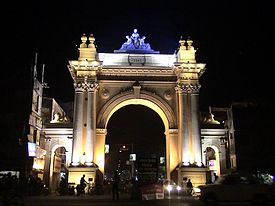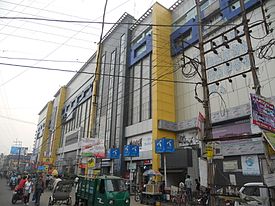Burdwan
|
Barddhaman বর্ধমান बर्दवान Burdwan Barddhaman |
||||||||
|---|---|---|---|---|---|---|---|---|
| Metropolitan City / Urban Agglomeration | ||||||||
Clockwise from the top : Curzon Gate, Bardhaman Science Centre(outside)
Maa Durga puja, Shopping Mall, Sarbamangala temple Railway Station The Gateway Of West Bengal
|
||||||||
| Nickname(s): *Royal Heritage City of West Bengal *City Of Peace | ||||||||
| Coordinates: 23°14′N 87°52′E / 23.233°N 87.867°ECoordinates: 23°14′N 87°52′E / 23.233°N 87.867°E | ||||||||
| Country |
|
|||||||
| State | West Bengal | |||||||
| District | Bardhaman District | |||||||
| Named for | Divisional Headquarters of South Bengal, Historical City of South Bengal | |||||||
| Government | ||||||||
| • Type | Municipality | |||||||
| • Chairman | Dr. Swarup Datta | |||||||
| Area | ||||||||
| • Metropolitan City / Urban Agglomeration | 59 km2 (23 sq mi) | |||||||
| Elevation | 30 m (100 ft) | |||||||
| Population (2016) | ||||||||
| • Metropolitan City / Urban Agglomeration | 509,856 | |||||||
| • Density | 8,600/km2 (22,000/sq mi) | |||||||
| • Metro | 522,445 | |||||||
| Languages | ||||||||
| • Official | Bengali, English, Hindi | |||||||
| Time zone | IST (UTC+5:30) | |||||||
| PIN | 713101, 713102, 713103, 713104 713141,713149 | |||||||
| Telephone code | +91-342 | |||||||
| Vehicle registration | WB42 | |||||||
| Lok Sabha constituency | Bardhaman-Durgapur | |||||||
| Vidhan Sabha constituency | Bardhaman Dakshin | |||||||
| Website | bardhaman |
|||||||
Bardhaman (Pron: ˈbɑ:dəˌmən) is a city of West Bengal state in eastern India. It is the headquarters of Bardhaman district, having become a district capital during the period of British rule. Burdwan, an alternative name for the city, has remained in use since that period.
The history of Burdwan is known from about 5000 BC (the Mesolithic or Late Stone Age). The origin of this name dates back to the 6th century BCE and is ascribed to Vardhaman Swami or Mahavira (599-527 BCE), the 24th Tirthankara of Jainism, who spent some time in Astikagrama, according to the Jain scripture of Kalpasutra. This place was renamed as Vardhamana in his honour.
The region has an average elevation of 40 metres (131 ft). The city is situated 1100 km from New Delhi and a little less than 100 km north-west of Kolkata on the Grand Trunk Road (NH-2) and Eastern Railway. The chief rivers are the Damodar and the Banka.
The first epigraphic reference to the name of this place occurs in a 6th-century AD copper plate found in Mallasarul village under Galsi Police Station. Archeological evidences suggest that this region, forming a major part of Radh Bengal, could be traced even back to 4000 BCE.
Burdwan police station has jurisdiction over Bardhaman municipal area and Burdwan I and Burdwan II CD Blocks. The area covered is 192.15 km. There are out posts at Barabazar, Muradpur, Keshabganj, Nutanganj and Birhata.2
Women police station Burdwan has jurisdiction over Bardhaman municipal area and Burdwan I and Burdwan II CD Blocks. The area covered is 192.15 km.
During the period of Jahangir this place was named Badh-e-dewan (district capital). The city owes its historical importance to being the headquarters of the Maharajas of Burdwan, the premier noblemen of lower Bengal, whose rent-roll was upwards of 300,000. Bardhaman Raj was founded in 1657 by Sangam Rai, of a Hindu Khatri family of Kotli in Lahore, Punjab, whose descendants served in turn the Mughal Emperors and the British government. The East Indian Railway from Howrah was opened in 1855. The great prosperity of the raj was due to the excellent management of Maharaja Mahtab Chand (died 1879), whose loyalty to the government especially during the "Hul" (Santhal rebellion) of 1855-56 and the Indian rebellion of 1857 was rewarded with the grant of a coat of arms in 1868 and the right to a personal salute of 13 guns in 1877. Maharaja Bijaychand Mahtab (born 1881), who succeeded his adoptive father in 1888, earned great distinction by the courage with which he risked his life to save that of Sir Andrew Fraser, the lieutenant-governor of Bengal, on the occasion of the attempt to assassinate him made by freedom fighters of Bengal on 7 November 1908.
...
Wikipedia







